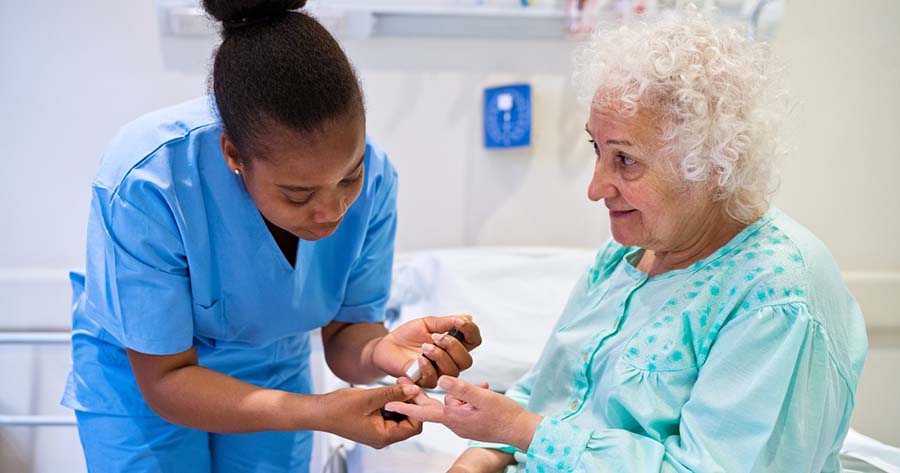Type 2 diabetes is a chronic lifelong disease for which there is no known cure. It incurs costs to both the individual and to the NHS that are staggering, due to comorbidities such as heart disease, renal failure, amputations and blindness. Total diabetes costs for 2009–10 have been estimated at £3.9 billion (National Audit Office, 2012). Diabetes is more prevalent in individuals from BME groups. Type 2 diabetes is up to six times more common in people of South Asian descent and up to three times more common among people of African and African-Caribbean origin (Department of Health, 2001). The Health Survey for England (Health and Social Care Information Centre, 2005) demonstrated that doctor-diagnosed diabetes is almost four times as prevalent in Bangladeshi men, and almost three times as prevalent in Pakistani and Indian men, compared with men in the general population. Among women, diabetes is more than five times as likely among Pakistani women, at least three times as likely in Bangladeshi and Black Caribbean women, and 2.5 times as likely in Indian women, compared with women in the general population (see Figure 1).
This increased prevalence of diabetes in BME groups is important as risk factors associated with progression of diabetes and organ injury, such as hypertension, are also known to be more common in African-Caribbean individuals (Williams, 1997). Furthermore, westernised Asians with type 2 diabetes have a much higher prevalence of cardiovascular disease and stroke (Williams, 1994; 1995) and those of Asian descent also have an increased risk of end-stage renal disease (Lanting et al, 2005).
Ethnic differences in diabetes care contribute to the more adverse outcomes for those from BME groups; women from BME groups in particular are reluctant to make use of health services due to language barriers, lack of available information and cultural beliefs (Szczepura, 2005).
Attitudes and beliefs: Causes of diabetes
It has been shown that individuals from BME groups are less likely to agree that diabetes is a chronic condition, a threat to their health or that it has a great impact on their lives (Skinner et al, 2002). Greenhalgh et al (1998) found the devastation of a diagnosis among British Bangladeshis was expressed in terms of acute complications, such as “collapse” and “dropping dead”. Only a minority of this group recognised the range of chronic complications related to diabetes and that the reduction in disability and prolongation of life was related to restoring the body’s internal balance through taking of particular foods and fighting the “germ” with medicine. There also seems to be a fatalistic approach to the weakening effect of diabetes on the body, along with the expected bodily decline of age, and that little could be done to reverse the process (Lawton et al, 2006).
The causes of diabetes seen from a combined South Asian frame of reference are varied; Meetoo and Meetoo (2005) compared these beliefs between Asian and Caucasian populations (see Table 1 overleaf). Naeem (2003) found that 32% of Kashmiri men believed the cause of diabetes was Allah’s will. Similarly, Greenhalgh et al (1998) found that illness is generally attributed to events or agents outside the body and suggests that this reflects the predominance of acute infectious illness in the recent cultural history of this group. All participants believed too much sugar and, to a lesser extent, other features of a Western diet were the primary causes of diabetes. They also noted that a change in climate and environment with migration to UK was a factor. The Asian health concept is of an ecological flow of substances between the environment, food and the human body; that there is a relationship between sugar, butter, ghee, body fat, bone marrow, semen and white vaginal discharge. There was an agreement that sugar is stored in the bone marrow and semen is produced from this; when the “calcium” in the bone marrow is depleted, the diabetes starts (Greenhalgh et al 1998).
Moss and McDowell (2005) in their phenomenological inquiry into rural Vincentians (Caribbean) and type 2 diabetes discovered some interesting beliefs regarding the causes of diabetes. These ranged from fertilisers, sweet foods, starchy foods, and the direct transfer of sweet things from the parents diet entering their blood and being transferred to the offspring (acknowledging an hereditary component).
Attitudes and beliefs: Dietary intake
There is much diversity in the variety and preparation of foodstuffs within BME groups, so sweeping generalisations cannot be made. We need to understand that diet-related health actions are affected by a variety of social and cultural influences and the nature of the individual’s diabetes experience.
Bangladeshi people do not classify food groups according to Western notions of nutritional content, but in terms of their perceived strength and digestibility (Greenhalgh et al, 1998). Strong foods include white sugar, lamb, beef, ghee, solid fat and spices. These food types were believed to worsen illnesses in the old or debilitated and there was an universal agreement that they should be avoided in diabetes. Raw, baked and grilled foods were considered indigestible. Meetoo and Meetoo (2005) found that 64% of Asian people supplemented their conventional treatment with food types that were perceived by them to be an effective hypoglycaemic agent, for example grapefruit, karalla or okra.
Festivals and fasting in South Asian people
The culturally important feasts, festivals and social events in Asian society demand both social duty and dietary compliance. At these times, sweet and rich foods are commonplace and there is usually a need for some compromise. Another key consideration is the management of diabetes during the month of Ramadan. Ramadan is one of the five pillars of Islam, which occurs in the ninth lunar month of the Islamic calendar. The duration of the fast differs with the geographical area and time of the year and for some the fast between dawn and dusk can last as long as 20 hours. This is a challenge for those individuals with diabetes who wish to observe the fast.
Diet in Caribbean people
Scott and Rajan (2000) surveyed the dietary habits of two generations of Caribbean people in South London. It was found that many older Caribbean people continued to eat their traditional foodstuffs out of a strong nostalgic attachment and cultural significance. The older generation were distrustful of takeaway food, citing suspicion of their content and preparation. The eating of typical Caribbean food on weekends was seen across all age groups, and religious observances, such as Christmas and Easter, were celebrated with traditional foodstuffs in older Caribbean people rather than traditional British foods. With regard to investigation of Caribbean understanding of a balanced meal, it was found that the older generation were least likely to understand the technical terms for foodstuffs, for example, carbohydrate, protein, fibre and roughage. The concept of starch was well understood.
The use of traditional medicine is a folklore practice that is well ingrained in Caribbean society (Mahebir and Gulliford, 1997). There is a belief that bush tea can cure diabetes and the use of bush teas, along with other plants, are used concurrently and interchangeably with prescribed medication (Moss and McDowell, 2005). The theme of body emissions is again seen within this BME group in this study; perspiration being related to the control of blood glucose and general well-being. The efficacy of certain herbal medicines is described, with Corila being the “strongest one of all”, Shaddom Vinni as a “very good thing for the sugar” and Elder Bush as “very good.”
Caribbean cuisine is generally highly seasoned, with a high salt content and, coupled with the common practice of frying and high saturated fat, this contributes to poor management of diabetes. This leads to the development of complications and a high rate of morbidity and mortality among native West Indians, particularly regarding risk of stroke, heart attack, high blood pressure and kidney problems.
Attitudes and beliefs: Weight
There is some debate about using conventional methods of identifying obesity in BME groups as different ethnic groups are associated with a range of different body shapes, and different physiological responses to fat storage (Gatineau and Mathrani, 2011). Therefore, an adjustment to body mass index and waist measurement has been made for South Asian populations. It is vital that the risk of elevated levels of these are conveyed to the individual regarding the development of type 2 diabetes.
Patel et al (2001) undertook a comparative study that focused on the mismatch between perceived and actual weight in South Asian and European women, both with and without diabetes. It was found that European women have a greater awareness of obesity compared with South Asian women, and this was evident (although not significantly) in those with normoglycaemia, previously unknown diabetes or impaired glucose tolerance (IGT) and overt diabetes. For those with previously undiagnosed diabetes and IGT, more South Asian women compared with European women perceived themselves to be the right weight despite being overweight (53.6% versus 30.0%). A significantly higher proportion of South Asian women were overweight compared to European women. This has important connotations as weight loss and maintenance of a normal body mass index is a vital part of diabetes management and prevention of type 2 diabetes.
Naeem (2003) found that 82% of Kashmiri men had been advised that they were overweight, but only 42% believed they actually had a weight problem. Furthermore, 96% believed being overweight did not matter. Interestingly, Greenhalgh et al (1998) found that when both Bangladeshi men and women were asked to choose photographs of healthy individuals, they chose large individuals. Large body size was generally viewed as having “more health” and thinness with “less health”. In contrast to the Kashmiri men, however, it was perceived among Bangladeshi people that “too much health” was undesirable, especially if diabetes had already weakened the body.
The process of assessing perception of body weight, health and attractiveness through the use of photograph choice has been used before. Scott (2001) investigated the health beliefs of Caribbean people in South London. The majority of Caribbean men and women chose individuals with a normal body mass index as representing health and attractiveness. The second largest majority group chose the underweight women and overweight men as representing health and attractiveness. There was no evidence that being large in size was culturally valued, as seen in other ethnic minority groups. When asked to associate different disease processes to the photographic images, only 4% of the interviewees were able to identify the risk of diabetes related to obesity and, interestingly, all 4% had diabetes themselves.
Attitudes and beliefs: Medication
Despite the perception that medication prescribed through the NHS is of a good quality, less than half of Indian and Pakistani people with diabetes reported taking oral hypoglycaemic agents (OHAs) as prescribed, and many try to reduce their intake of tablets (Lawton et al, 2006). According to Lawton et al, there is little understanding of the need for continued use if not feeling unwell. In the study, many altered their dosage without consulting a healthcare professional and believed that continued use of many tablets was detrimental to their health. Advice on reduction of OHAs during the holy month of Ramadan gives some credence to this ideology, and it is certainly an issue that I have dealt with in clinical practice. Meetoo (2004) found that when people wish to indulge in food that may impact on blood glucose, described as “a little bit of pleasure”, they will increase their medication accordingly.
Others describe the stigma of the visibility of insulin therapy and the wish not to advertise the fact that they have a chronic disease, which they describe as a problem within their culture (Lawton et al, 2006).
The key recommendations for health professionals made by Lawton et al (2006) are based on sound identification of various factors that impinge on both Pakistani and Indian individuals’ ability to adhere to OHAs. These include the following:
- Be aware that some Pakistani and Indian people may adjust OHA treatment according to symptoms.
- Ask individuals in a non-judgemental way if they adjust their drugs themselves.
- Explore each individual’s understanding of and concerns about taking OHAs.
- Be aware that some Pakistani and Indian people perceive the need to balance “strong” OHA drugs with dietary changes that may not be appropriate to their diabetes management.
- Ask individuals if (and how) they adjust their diet because of their OHA treatment and vice versa.
- Ask individuals directly about any symptoms they attribute to their diabetes and their treatment.
Lans (2006) describes Caribbean folk medicine as a mixture of European folk medicine, scientific medicine, African-based practices, Amerindian medicine and Indian-based medicine. This does not allow for generalisations in this group regarding attitudes to diabetes. The management of illness through cathartic remedies designed to remove heat from the system is again seen in Lans’ work in Trinidad and Tobago. Activities, food and medicines are classified in this manner. The use of prescribed medication, as seen by Moss and McDowell (2005), was more to do with the relationship with health personnel and the dependence of being issued a prescription. They found that adherence to prescribed medication was practically non-existent in their cohort. Adherence to medication was affected by beliefs on disease severity, ability to carry out self care, treatment benefits and the efficacy of herbal remedies.
Attitudes and beliefs: Exercise/activity
Pakistani and Indian people with diabetes have knowledge of the need for regular activity, but verbalise many reasons as to why they do not adhere to advice given by health professionals. Lawton et al (2006) found that there were many interwoven reasons for not exercising. Some involved the practical consideration of lack of time. The work ethic of Asian families means long, often unsocial hours of work and their priorities are firmly with the family before themselves. To take time out for exercise would be seen as a selfish act and, therefore, culturally inappropriate. However, some participants described running on the spot if they monitored their blood glucose and found it to be elevated, and described satisfaction on observing the reduction post exercise.
When we separate South Asian groups, it has been found that people from the Bangladeshi community have markedly lower levels of physical activity than other South Asian groups, while those of Indian ethnicity have the highest levels, although this is still lower than the White population (Hayes et al, 2002).
There are real difficulties for women from BME groups in partaking in exercise. Many older women from BME groups came here in adulthood to be married and have not been socialised into spending time outdoors. Many do not leave their houses for fear of attack, and the relative poverty and socio-economic disadvantages play an important part. Command of the English language is often poor and increases their perceived vulnerability. Many have a dislike of going outside in cold, wet and windy weather and there is a perception that diabetes has weakened and aged the body. This has a de-motivational effect as far as the uptake or maintenance of physical activity is concerned. A loss of confidence following a diagnosis of diabetes was cited as a contributory factor in restricting activities (Naeem, 2003).
The context of health and fitness seems to have little cultural meaning for people from Bangladesh (Greenhalgh et al, 1998). In fact it was seen as a potential cause of ill health or physical weakness. Despite verbalising the positive effect of sweating in their home climate, this was not translated into the positive effects of sweating through exercise. Greenhalgh et al (1998) offer an explanation of the negative connotations surrounding exercise, as there is no expression for exercise in the Sylheti language. The closest translation is “beyam”, which is obscure and the prefix “bey” is associated with negativity.
Diabetes education for BME groups
The provision of diabetes education for individuals from BME groups is complex, with language difficulties being a potential barrier, particularly in older people. As diabetes is a chronic condition, empowering the individual from a BME group requires specific attention to health beliefs and attitudes. There have been a variety of projects that have adapted structured education for BME groups. These involved the adaptation of existing structured education programmes, such as DESMOND and Diabetes X-PERT Programme. Interestingly, the tradition of story-telling in some BME groups inspired the use of this medium for educational programmes and this was facilitated by bi-lingual health advocates.
The importance of link workers is supported by Moss et al (2008) in the Heartlink project. The need to identify the leaders (usually religious) of the various communities was seen as vital and the link worker was an integral part of the team. The Taff Ely Diabetes Education Programme (Husband and Chegwidden, 2002) was adapted to be used with small groups of people newly diagnosed with diabetes attending venues (usually places of worship). They used a mostly visual mode of learning, with words translated in to the relevant language, where possible.
Greenhalgh et al (2005) makes specific reference to older Bangladeshi women involved in education programmes. Despite residing in the UK for 20–30 years, very little English was spoken, but word of mouth increased interest in the lunch club from 8 to 42 members. Although appearances of the sessions could be viewed as chaotic, the format, which evolved from the needs of the group, was viewed as fulfilling and enjoyable.
This chaotic approach is something I have seen firsthand, through participation in the annual minority ethnic communities health fair in Cardiff. The day involves educational sessions on heart disease, retinopathy, diabetes, depression and more. The days are well attended and there are over 50 health and social care stalls, with free blood pressure, blood glucose and dental checks. It has been advised that healthcare professionals use their judgement when adapting mainstream education programmes for people from BME groups (Diabetes UK, 2005).





Key scientific developments presented at the conference.
6 Aug 2025